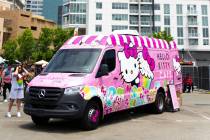It’s OK to embrace your ugly Christmas sweater
Credit — or, maybe, blame — Bill Cosby's sweaters on "The Cosby Show" or Chevy Chase's sweaters in "National Lampoon's Christmas Vacation," or every dad, brother, uncle or grandfather who ever felt compelled to don his most questionable apparel to seek a few laughs on the holiday party circuit.
But, whatever its genesis, the Ugly Christmas Sweater has, for whatever bizarre reason, become a solid fashion staple for the Yuletide season.
"Star Wars" sweaters. Grinchy sweaters. Sweaters featuring bright, elaborate, garish depictions of movie Minions, funny sayings, scary looking Christmas trees and misshapen reindeer. Even sweaters festooned with Christmas ornaments and flashing colored lights.
During the past decade-and-a-half, Ugly Christmas Sweaters have become a thing, embraced, first, by hipsters striving to make an ironic statement about the holiday season and more recently by anybody with a sense of humor who doesn't mind looking goofy in the service of Christmas.
There are Ugly Christmas Sweater runs across the country (Las Vegas' was Dec. 5) and a national "Ugly Christmas Sweater Day," which this year arrives Dec. 18. Even Macys.com — the online arm of the department store made famous in the film "Miracle on 34th Street," in which not one Ugly Christmas Sweater was worn — offers an entire selection of what it redundantly calls "Ugly Christmas Sweater Sweaters."
How did an otherwise noble, serviceable garment become fodder for Yuletide derision? Note, first, says Deirdre Clemente, that the sweater is a relatively new addition to the American closet.
Clemente, an assistant professor of history at the University of Nevada, Las Vegas who studies 20th century American cultural history, says the sweater began appearing in the United States only about 1910, and then primarily in the form of the Ivy Leaguer's letterman's sweater.
During the next few decades, "you're really starting to see the sweater industry develop," Clemente continues, with mostly West Coast-based knitwear manufacturers using knitting machines to make swimsuits, sweaters and hosiery and spurring development of the American knitwear industry in general.
During the late '20 and early '30s, and then on through the '40s, '50s and '60s, sweaters earned a reputation as a casual garment that could be made more feminine and more distinctive with such add-ons as pompons, chains and brooches.
"Sweaters have a history of being fun," Clemente says, particularly among younger people. And among men — who are, let's face it, the prime perpetrators of Ugly Christmas Sweaters — the introduction of synthetic fibers during the late '50s and '60s allowed the creation of sweaters featuring brighter, bolder colors and designs.
Eventually came "this idea of Christmas sweaters that you had for a sort of a fun purpose and for very time-specific purposes," Clemente says.
Most informal histories trace the current renaissance of the Ugly Christmas Sweater back to the early 2000s, perhaps as a retro, colorful counterbalance to a scary 21st century. Clemente approves.
"I think it's super-exciting," she says. "I love to see men wear ugly Christmas sweaters. I think it's funny and it says, 'I'm fun. I don't take myself too seriously.'
"I'm a huge knitwear person. If somebody says, 'Your house is burning, you can take photos of your kids or some of your hand-knit sweaters,' I'm, like, 'I'll remember those kids,' because I just love knitwear. So I would say I've been watching (the Ugly Christmas Sweater trend) for a long time, because although I don't own one, I probably should."
Clemente's advice: if you're going to go ugly for Christmas, go ugly. Even in the case of classier hand-knit Christmas sweaters, "you can get real down and dirty when you're making something," she says. "I'd love to see people out there making ugly Christmas sweaters."
Contact reporter John Przybys at jprzybys@reviewjournal.com or 702-383-0280 or follow @JJPrzybys on Twitter.

















